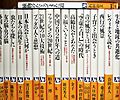Bookbinding facts for kids
Bookbinding is the cool process of putting a book together! Imagine all the pages of your favorite story. Bookbinding is how they get neatly placed inside a cover and attached to the spine (that's the closed edge of the book). This can be done by sewing them together or using strong glue.
For a long time, bookbinding was a special art form, done by hand. But in the 1800s, during the Industrial Revolution, machines were invented to help. Now, most books you see are made quickly in factories using these machines.
A person who binds books is called a bookbinder. Today, books made by hand are often very special and cost more than factory-made ones. Being a bookbinder is a skilled job. They need to be good at things like measuring, cutting, gluing, working with leather, and understanding graphic arts and different fabrics.
Contents
What is Bookbinding?
Bookbinding is basically giving a stack of paper pages a strong cover and a spine. This protects the pages and makes them easy to read and store. Think about your textbooks or comic books – they all went through a bookbinding process!
Why Do We Bind Books?
Books are bound for several important reasons:
- Protection: The cover and spine keep the pages safe from damage, like tearing or getting dirty.
- Organization: Binding keeps all the pages in the correct order. Imagine trying to read a book if the pages were just loose!
- Durability: A well-bound book can last for many years, even centuries.
- Readability: It makes books easy to hold, open, and read comfortably.
- Appearance: Book covers can be very beautiful and artistic, making books attractive.
How Are Books Made?
The way books are made has changed a lot over time.
Traditional Hand Binding
In the past, and still today for special books, bookbinders did everything by hand.
- First, the pages were printed and folded into sections called signatures.
- These signatures were then sewn together through their folds.
- Next, the sewn pages were attached to a spine piece, often made of leather or cloth.
- Finally, hard covers (called boards) were added to the front and back, and then covered with decorative materials like leather, cloth, or special paper.
- Sometimes, the covers were decorated with gold or other designs.
Modern Factory Binding
Today, most books are made using large machines in factories.
- Pages are printed in huge sheets and then cut and folded.
- For paperback books, the pages are glued together at the spine. This is called perfect binding.
- For hardcover books, the pages might still be sewn together by machine, or glued, and then attached to a strong, stiff cover.
- Machines quickly add the cover, trim the edges, and even package the books. This allows millions of books to be made every year!
Types of Bookbinding
There are many different ways to bind a book, depending on how it will be used and how long it needs to last.
Hardcover Binding
Hardcover books have stiff, strong covers, usually made of cardboard covered with cloth, paper, or leather. The pages are often sewn together before being attached to the cover. These books are very durable and last a long time. They are common for novels, textbooks, and reference books.
Paperback Binding
Paperback books have flexible covers, usually made of thick paper or cardstock. The pages are almost always glued together at the spine. They are lighter and less expensive than hardcovers, making them popular for many types of books, like fiction and magazines.
Other Binding Styles
- Spiral Binding: Uses a plastic or metal coil threaded through holes along the edge of the pages. This allows the book to lie completely flat when open, which is great for notebooks or cookbooks.
- Saddle Stitching: Used for thin books or booklets, like comic books or brochures. The pages are folded in half and then stapled through the fold along the spine.
- Case Binding: This is another name for hardcover binding, where the pages are sewn and then put into a "case" (the hard cover).
The Art of Bookbinding
Even with all the machines, bookbinding is still an art. Bookbinders can create amazing, unique books. They might use special leathers, beautiful patterned papers (like marbled paper), or add fancy designs to the cover. Some bookbinders even restore old, damaged books, carefully repairing them so they can be enjoyed for many more years.
Bookbinding combines craftsmanship, art, and engineering to turn loose pages into the wonderful objects we call books!
Images for kids
-
Early medieval bookcase containing about ten codices depicted in the Codex Amiatinus (c. 700)
-
Modern paperback spines
See also
 In Spanish: Encuadernación para niños
In Spanish: Encuadernación para niños













